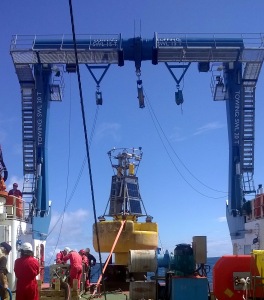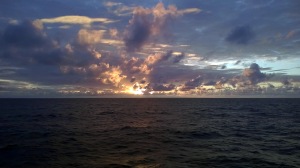Hello!
Welcome to my first blog post! This post is a retrospective account of my time on the RRS Discovery research cruise to the Porcupine Abyssal Plain (PAP) Observatory in June/July of 2015.
The ship set sail on the 20th of June from Liverpool and this meant it was time to find my ‘sea legs’! Whilst I had heard the term many times before I never truly appreciated it’s meaning but thankfully, a couple of days into the cruise my body had adapted to the motion. It was a huge relief to find that I wasn’t seasick and that it won’t hinder any future oceanographic research I wish to undertake.
My main reason for going on the cruise was to collect data about slow-sinking carbon at the PAP site which would contribute towards my masters project. My project is aiming to determine what controls slow-sinking carbon in different regions and how important it is in relation to carbon storage in the ocean. These carbon particles are collected using equipment called Marine Snow Catchers – which are 100 liter water samplers. The snow catchers are deployed into the water column to sample at a chosen depth and once on deck they sit for two hours whilst particles settle out. The water is then filtered for different properties such as carbon content, chlorophyll content etc. The filters will be analysed back on dry land and hopefully will show some interesting results.
The rest of my time working on the cruise was spent carrying out ammonium concentration measurements of the water column and of bacteria incubation’s. Ammonium was measured to further understand the role of bacteria in consuming carbon in the water column which also affects carbon storage. This was my first time measuring ammonium and carrying out ‘real’ biogeochemistry lab work, which I thoroughly enjoyed. I was surprised to discover how rapidly ammonium was turned over in the water column with timescales of less than 24 hours due to processing by bacteria. The bacteria were clearly working as hard as all the scientists on board!
There was a great range of different sampling taking place on board from water sampling, photographing the water column, trawling for deep dwelling species… the list goes on. However, the main objective of the cruise was to retrieve the PAP buoy which collects time-series measurements of temperature, current speed, pressure and water column chemistry using sensors (e.g. carbon dioxide, pH, oxygen, phosphate) as well as other oceanographic and meteorological data. The PAP buoy is retrieved yearly for a ‘service’ in which the sensors are tested, fixed if necessary and re-calibrated before being reattached to the mooring and deployed. The buoy even got power washed to remove any algae, barnacles and other marine life that were growing on it. One of the most impressive parts of the cruise was watching the mooring being deployed which took incredible skill due to it’s size – and the pressure of a crowd of onlooking scientists of course! The Sea Systems guys who were deploying the buoy were impressively calm and got a well deserved round of applause once it was safely in the water.

This picture was taken just before the PAP buoy was deployed back into the water column. The deployment was a great success and all of the sensors were ‘talking’ which was a great relief to the sensor team.
I had a fantastic time on the cruise and some highlights include sampling from CTD’s whilst watching sunsets disappear behind the horizon, sunbathing on the front deck post-sampling, meeting some fantastic people and laughing our way through our time on board, the amazing food on board that really catered to vegetarians (my thanks to the chefs), trying Marmite for the first time (I am firmly on team Hate It with the response of ‘why would someone eat this on purpose?!’) and watching a pod of Pilot whales bobbing near the boat. I hadn’t studied large marine life in my degree, so I’d never heard of Pilot Whales before but they were beautiful, majestic and serene creatures. The first pod we saw had about 15 whales and they stayed near the boat for about 20 minutes. Safe to say I was mesmerized and I have a new favourite type of whale!
In summary, the cruise was an enriching experience that I am truely grateful for as not many MSc students get such an opportunity. Now that I’m back on dry land and it’s time to catch up on some sleep and crack on with my master’s project. Thanks for reading this post, I hope you enjoyed my first but hopefully not last blog.
Chelsey

